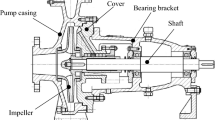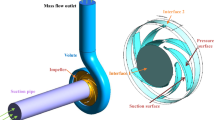Abstract
A cavitation model with thermodynamic effects for cavitating flows in a diffuser-type centrifugal pump is developed based on the bubble two-phase flow model. The proposed cavitation model includes mass, momentum, and energy transportations according to the thermodynamic mechanism of cavitation. Numerical simulations are conducted inside the entire passage of the centrifugal pump by using the proposed cavitation model and the renormalization group-based k-ɛ turbulent model coupled with the energy transportation equation. By using the commercial computational fluid dynamics software FLUENT 6.3, we have shown that the predicted performance characteristics of the pump, as well as the pressure, vapor, and density distributions in the impeller, agree well with that calculated by the full cavitation model. Simulation results show that cavitation initially occurs slightly behind the inlet of the blade suction surface, i.e., the area with maximum vapor concentration and minimum pressure. The predicted temperature field shows that the reduction in temperature restrains the growth of cavitating bubbles. Therefore, the thermodynamic effect should be treated as a necessary factor in cavitation models. Comparison results validate the efficiency and accuracy of the numerical technique in simulating cavitation flows in centrifugal pumps.
Similar content being viewed by others
References
R. B. Medvitz et al., Performance analysis of cavitating flow in centrifugal pumps using multiphase CFD. Journal of Fluids Engineering, 124 (2002) 377–383.
H. R. Shin, K. Takafumi and L. Huiying, Propeller cavitation study using an unstructured grid based Navier-Stoker solver. Journal of Fluids Engineering, 127 (2005) 986–994.
S. Inanc and W. Shy, Interfacial dynamics-based modeling of turbulent cavitating flows, part-I: model development and steady-state computations, International Journal for Numerical Methods in Fluids, 44 (2004) 975–995.
A. K. Singhal, et al., Mathmatical basis and validation of the full cavitation model. Journal of Fluids Engineering, 124 (2002) 617–624.
FLUENT Inc. FLUENT 6.3 user’s guide, Lebanon (2008).
A. E. Catania, A. Ferrari and E. Spessa, Temperature variations in the simulation of high-pressure injection-system transient flows under cavitation. International Journal of Heat and Mass Transfer, 51(7–8) (2008) 2090–2107.
G. Eric and F. P. Regiane, Constraints on equation of state for cavitating flows with thermodynamic effects. Applied Mathematics and Computation, 217(11) (2011) 5095–5102.
H. Shuji, G. Yuki and F. Takaki, Influence of temperature on erosion by a cavitating liquid jet. Wear, 260(11–12) (2006) 1217–1223.
Y. Yoshiki et al., Thermodynamic effect on rotating cavitation in an inducer. Journal of Fluids Engineering, 131 (2009) 13021–13027.
F. Jean-Pierre et al., Thermodynamic effect on a cavitating inducer-part I: Geometrical similarity of leading edge cavities and cavitation instabilities. Journal of Fluids Engineering, 132 (2010) 3031–3038.
F. Jean-Pierre et al., Thermodynamic effect on a cavitating inducer-part II: Geometrical similarity of leading edge cavities and cavitation instabilities. Journal of Fluids Engineering, 132 (2010) 13041–13049.
W. Yulin et al., Simulations of unsteady cavitating turbulent flow in a Francis turbine using the RANS method and the improved mixture model of two-phase flows, Engineering with Computers, 27 (2011) 235–250.
B. B. Mikic, W. M. Rohsenow and P. Griffith, On bubble growth rates, International Journal of Heat and Mass Transfer, 13(4) (1970) 657–666.
Author information
Authors and Affiliations
Corresponding author
Additional information
Tang Xue-lin received the Bachelor’s Degree in fluid engineering from Lanzhou University of Technology in 1992, the Master Degree in fluid engineering from Yanshan University in 1995 and the Ph.D. degree of engineering in fluid machinery from Tsinghua University in 2003, in China. Currently, he is a professor in College of Water Conservancy & Civil Engineering, China Agricultural University, China. His research interests include the theory, design and single/two-phase CFD in fluid machinery and fluid engineering.
Rights and permissions
About this article
Cite this article
Tang, Xl., Bian, Ly., Wang, Fj. et al. Numerical investigations on cavitating flows with thermodynamic effects in a diffuser-type centrifugal pump. J Mech Sci Technol 27, 1655–1664 (2013). https://doi.org/10.1007/s12206-013-0413-3
Received:
Revised:
Accepted:
Published:
Issue Date:
DOI: https://doi.org/10.1007/s12206-013-0413-3




